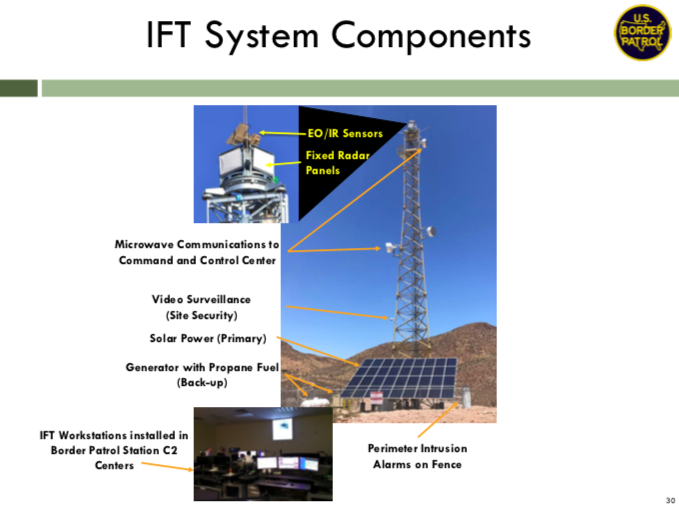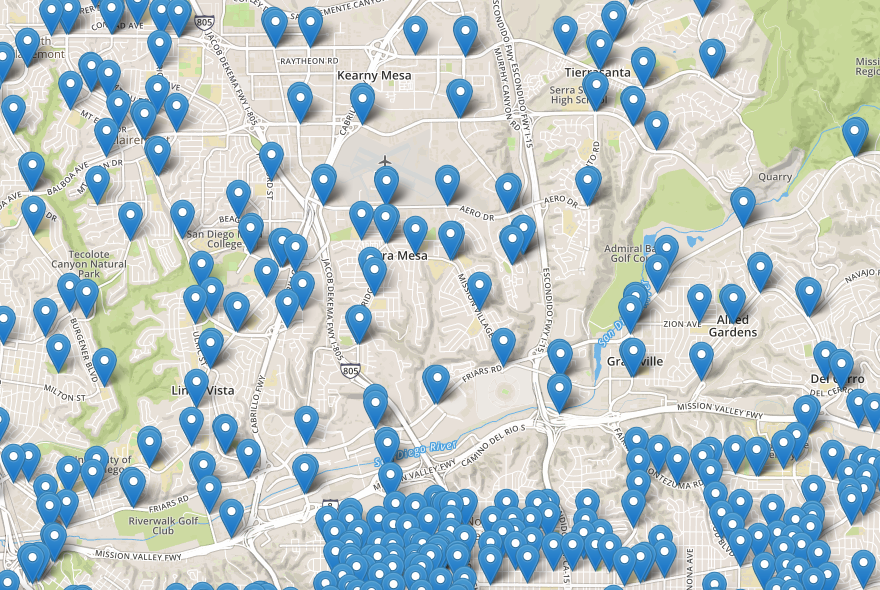
 With a population of 3.3 million (larger than the state of New Mexico), San Diego County is the most populous county along the U.S.-Mexico border. San Diego shares approximately 60 miles of the border, with the San Ysidro Port of Entry as the busiest border crossing in the country.
With a population of 3.3 million (larger than the state of New Mexico), San Diego County is the most populous county along the U.S.-Mexico border. San Diego shares approximately 60 miles of the border, with the San Ysidro Port of Entry as the busiest border crossing in the country.
The two largest law enforcement agencies are the San Diego Police Department and the San Diego County Sheriff’s Office, with the latter also providing contract policing services to smaller municipalities in unincorporated areas. Nine cities in the San Diego area have their own police department, as does the Port of San Diego and the major universities, including San Diego State University, University of California San Diego, and California State University San Marcos.
San Diego County is unique in that agencies throughout the region coordinate on public safety matters and information sharing through the Automated Regional Justice Information System (ARJIS), which is overseen by the San Diego Association of Governments (SANDAG). ARJIS manages desktop and mobile apps through which law enforcement agencies access sophisticated data analysis and records retrieval software systems. This includes Coplink, which was pioneered by the Tucson Police Department and the University of Arizona Artificial Intelligence Lab. ARJIS has also ushered in countywide face recognition and automated license plate reader programs.
Law enforcement agencies in San Diego have long been early adopters of surveillance technology, including cell-site simulators, smart streetlights, and mobile biometric technology. Body-worn cameras and drones are common throughout the region. The federal government also keeps a close eye on the border region with technologies that include automated license plate readers and surveillance towers.
Updated January 13, 2020: A statewide moratorium on face recognition attached to mobile devices went into effect on January 1, 2020. As a result, the regional face recognition program operated by the San Diego Association of Governments, and used by 32 agencies, was shut down. We have deleted references to the face recognition program from this report. Read more here.
Quick Links:
- Automated License Plate Readers
- Body-Worn Cameras
- Cell-Site Simulators
- Drones
- Smart Streetlights
- Gunshot Detection
- Private-Public Camera Sharing
- Mobile Surveillance Systems
- Fusion Center and Palantir
- Federal Surveillance Technology
Automated License Plate Readers

San Diego County Sheriff's Department patrol car with mobile ALPR. Source: County News Center
Automated license plate readers (ALPRs) are networks of cameras used to track the movements of vehicles. Police attach cameras to patrol cars or fixed locations, like highway overpasses, to amass a searchable database that can reveal a driver’s movement. Police also create “hot lists” of plates of wanted vehicles and people to get real-time alerts whenever the cars are photographed by ALPRs.
The San Diego County Sheriff’s Department operates an ALPR network and shares the data with other agencies through ARJIS. Other agencies contribute data to the system, which is retained for one year.
Many agencies in San Diego County operate their own ALPR systems. According to the San Diego Union-Tribune, the Carlsbad Police Department has the largest network of fixed ALPR cameras in the county. As of 2018, Carlsbad had 51 ALPR cameras surveilling 14 intersections, with 35 more approved for installation over the next year. Carlsbad Police also operate six patrol cars equipped with ALPRs. The San Diego Police Department also has vehicles equipped with ALPRs, which are sometimes driven by volunteers.
Other entities with ALPRs include: Coronado Police Department, Chula Vista Police Department, El Cajon Police Department, Escondido Police Department, La Mesa Police Department, Oceanside Police Department, and San Diego Harbor Police Department.
Federal agencies actively use ALPRs in the region, including the U.S. Drug Enforcement Administration and U.S. Customs and Border Protection. In 2010 in Del Mar, U.S. Immigration and Customs Enforcement conducted one of the most infamous uses of ALPRs: ICE agents scanned license plates in a parking lot of a gun show and compared those license plates to cars crossing the border to try catching gun smugglers.
For more information:
- EFF: California Automated License Plate Reader Policies
- ARJIS: Acceptable Use Policy for the Regional License Plate Reader System
- Voice of San Diego: SDPD May Not Be Following State Law on License Plate Readers
Learn more about automated license plate readers.
Body-Worn Cameras

Carlsbad Police Department officers with BWCs. Source: Carlsbad Police Department Facebook
Body-worn cameras (BWCs) are small devices affixed to an officer’s uniform that capture video and audio of the officer’s encounters with the public. Often billed as a measure to enhance police accountability, BWCs also function as a mobile police surveillance network.
As of 2018, the San Diego Police Department deployed 1,348 BWCs manufactured by Axon. Officers are instructed to activate BWCs in all law enforcement related contacts. The BWCs can operate for up to 12 hours of continuous buffering and can record ten hours of continuous video and audio media. In 2017, the San Diego County Sheriff began implementing a $1.1-million program to equip 860 deputies with Axon-brand BWCs.
Other agencies using BWC include: Carlsbad Police Department, Oceanside Police Department, Chula Vista Police Department, Escondido Police Department, Coronado Police Department, California State University Police Department, San Diego State University Police Department, La Mesa Police Department, and El Cajon Police Department.
For more information:
- Aaron Swartz Day Police Surveillance Project: Public Records from San Diego County Sheriff’s Department
- San Diego Police Department: Procedure for Axon Body Worn Cameras
- 10 News San Diego: Evolving body camera policies for San Diego law enforcement
Learn more about body-worn cameras.
Cell-Site Simulators
Cell-site simulators, also known as Stingrays or IMSI catchers, are devices that masquerade as cell-phone towers, tricking phones within a certain radius into connecting to the device rather than a tower. Law enforcement often uses these devices to find the unknown location of a suspect or to identify the unknown people present at a particular time and place
The San Diego Police Department has two portable cell site simulators and one cell site simulator mounted to a designated vehicle, according to NBC San Diego. After a public records lawsuit brought against the City of San Diego and the San Diego Police Department (SDPD) by the First Amendment Coalition, the SDPD released heavily redacted documents showing their use of cell-site simulator technology. The documents did reveal that the devices can locate a phone to within two meters. The devices also have the capability to intercept communications, although SDPD says it does not use that feature.
According to SDPD’s policy for cell-site simulators, the department does not share the technology with other agencies. Between 2010 and 2015, SDPD used the device in 26 investigations.
For more information:
- KPBS: Records Released On SDPD’s Use Of Stingray Cellphone Tracking Device
- First Amendment Coalition: FAC suit against San Diego yields previously secret records on police use of invasive cell phone surveillance tool
- SDPD: Cell-site Simulator Policy
- NBC San Diego: SDPD Used Cell Phone Tracking Technology to Help With 26 Investigations
Learn more about cell-site simulators.
Drones

Proposed drone coverage zones in Chula Vista. Source: City of Chula Vista community forum presentation
Drones are remote-controlled vehicles that police use for aerial surveillance. Local agencies generally use compact, less expensive drones known as small unmanned aerial systems (sUAS) or quadrotors, as opposed to the larger systems deployed by the military and the Department of Homeland Security.
As of October 2017, the San Diego County Sheriff’s Department operates a 10-drone program, according to Government Technology. A member of the sheriff’s drone unit said in an interview with A&E that the agency flew 87 missions in 2017 alone. The National City Police Department, the San Diego Harbor Police Department, and San Diego Police Department also use drones.
The Chula Vista Police Department deploys four types of drones: the DJI Inspire 1, the DJI Mavic Pro, the DJI Phantom 4, and the DJI Matrice M200. In 2019, City of Chula Vista intends to expand its drone program to nine fire stations, where drone operators can use the technology to photograph crime scenes and "locate homeless encampments in difficult terrains." According to Fox 5, CVPD launched more than 1,000 missions in its first year, resulting 130 arrests. CVPD also posts video showing each drone flight on a map.
The Escondido Police Department established it drone program 2017 and has flown 117 missions using three DJI drones as of June 2019. In 2019, Escondido Police received a $41,670 grant to purchase a larger DJI Matrice 210 drone, which is equipped 30-power zoom lens and FLIR thermal imaging.
For more information:
- The Coast News: Escondido to consider police drone, immigration enforcement federal dollars
- City of Chula Vista: Drones as First Responders, a Community Forum
- A&E: How Law Enforcement Is Using Drones to Aid in Search and Rescues
Smart Streetlights
Click to open interactive map of smart streetlights throughout San Diego.
As part of a “smart city” initiative to ostensibly cut down on the city’s energy footprint, San Diego partnered with AT&T and General Electric to install and upgrade 14,000 streetlights, including 3,200 street lights equipped with sensor nodes that can test air quality, and measure measure traffic flow. However, this program also blanketed entire neighborhoods with advanced surveillance equipment. The streetlight sensors use gunshot detection technology and can capture audio and video. According to police policies, police can access these recordings within five days of a crime being reported, but the data can also be used for incident mapping and crime analysis. The policies also indicate SDPD may one day adopt advanced “video-based analytical systems” to monitor the feeds.
For more information:
- City of San Diego: San Diego Deploys the World’s Largest Smart City Platform
- GCN: San Diego preps largest smart city platform
- Digital Trends: How 3,000 street lights turned San Diego into America’s smartest city
- Voice of San Diego: Public, Council Were in the Dark on Police Access to ‘Smart’ Streetlights
- San Diego Police Department: Procedure for intelligent streetlights
Gunshot Detection
Acoustics gunshot detection system are networks of microphones that listen for the sounds of gunshots and then triangulate the location in order to alert the police. The most common vendor is Shotspotter.
The San Diego Police Department operates ShotSpotter. The sensors determine the time of a shooting, how many rounds are used and how many shooters are present, according to a report from Government Technology. All audio data is retained for 72 hours. ShotSpotter has been installed in Valencia Park, Skyline, O’Farrell and Lincoln Park neighborhoods. In addition, San Diego’s smart streetlight technology can also perform gunshot detection.
For more information:
- Aaron Swartz Day Police Surveillance Project: Public records on gunshot detection from San Diego Police Department
- KPBS: Pros And Cons Of San Diego’s Gunshot Detection System
Private-Public Camera Sharing
Ring, a company owned by Amazon that sells Internet-connect “doorbell cameras,” has begun partnering with law enforcement agencies in San Diego. The company markets cameras that stream live footage from people’s doorsteps to consumers, and residents are encouraged to share video with police through Ring’s “Neighbors” app. Since 2018 five agencies—Chula Vista Police Department, La Mesa Police Department, San Diego County Sheriff’s Department, Carlsbad Police Department, and Oceanside Police Department—have signed partnership agreements with Ring, according to Voice of San Diego.
While the San Diego Police Department has not signed an agreement with Ring, in 2010 the agency created a program to connect private surveillance cameras to its network so first responders can view live footage before arriving at active crime scenes. “Operation Secure San Diego,” however, stalled after running into technical difficulties, Voice of San Diego reported in 2014. Two years later, the San Diego Reader reported SDPD was again actively pursuing participants in the program.
For more information:
- Voice of San Diego: Five Local Police Agencies Are Partnering With Doorbell Surveillance Company
- Voice of San Diego: San Diego’s Bumbling Big Brother
- San Diego Reader: SDPD would like permission to access your cameras
For more on Amazon’s Ring products.
Mobile Surveillance Systems

In 2011, the San Diego Police Department acquired a TerraHawk Mobile Utility Surveillance Tower (MUST)—a van with an observation compartment on top that can be lifted 25-feet in the air—for $200,000. Two years later, the agency purchased three mobile surveillance trailers, which feature an extendable pole outfitted with dome cameras. These systems are deployed at public events such as San Diego Comic-Con.
Fusion Center and Palantir
The San Diego Law Enforcement Coordination Center (SDLECC) is one of 79 federally designated “fusion centers” nationwide that conducts large scale intelligence analysis and information sharing between local, state, and federal agencies. Like other fusion centers in California, SDLECC uses software from Palantir Technologies to sift through disparate big data sources. The Gotham software, which was purchased for SDLECC by the San Diego County Sheriff’s Department in 2013, currently contains 53-million data “objects” and can be accessed by more than 115 law enforcement staffers. Over the next three years, San Diego County will spend $493,000 on system maintenance. Palantir has garnered controversy due to its use in intelligence gathering by law enforcement agencies and because it provides similar services to ICE.
SDLECC has a troubled history with surveillance technology. A 2012 U.S. Senate investigation found that the fusion center had spent $25,000 on advanced surveillance tech, “most of which was so sophisticated it eventually returned it for simpler devices.” The center also spent $55,000 on 55 flat-screen televisions for “open-source monitoring,” which the Senate discovered was actually just watching the news. Fusion center officials told Senate staff the purchase was a “huge mistake” and the director had been fired.
For more information:
Federal Surveillance Technologies

The components of an integrated fixed tower. Source: Border Patrol industry day presentation
U.S. Customs and Border Protection (CBP) monitors the border using large MQ-9 Predator B drones and surveillance blimps called aerostats, however these technologies are used infrequently in the San Diego area, according to a 2017 Government Accountability Office report. Between 2014 and 2016, aerostats only assisted in four apprehensions in the San Diego area. Meanwhile, CBP told GAO it does not fly many mission in Southern California due "due to airspace restrictions related to the volume of commercial air traffic."
Throughout the border region, CBP has installed surveillance structures called Integrated Fixed Tower systems (IFTs) that include electro-optical and infrared sensors, video cameras, and radar systems that transmit back to workstations at border patrol centers. CBP has installed Remote Video Surveillance Systems (RVSS) that provide short, medium, and long-range surveillance through cameras, radio, and microwave transmitters that mount onto stand-alone towers and structures. According to the Government Accountability Office, there are 41 RVSS and two IFT systems in the San Diego Sector.
CBP also mount long-range surveillance systems on patrol vehicles. These Mobile Surveillance Capability (MSC) systems are 25-foot towers with video and radar. According to CBP, an MSC “automatically detects and tracks items of interest and provides the agent/operator with data and video of the observed subject.”
For more information:
- Government Accountability Office: Border Patrol Is Deploying Surveillance Technologies but Needs to Improve Data Quality and Assess Effectiveness
- U.S. Border Patrol presentation on IFT/RVSS
- CBP testimony: Securing the Border: Fencing, Infrastructure, and Technology Force Multipliers
Last updated December 17, 2019.




